Tourism as a Solution for the Economic Revitalization of an American College Town
Abstract
:1. Introduction
Literature Review
2. Method and Analysis
2.1. Method
- What makes Charleston an attractive city to be living in?
- What are the areas of improvement that the city of Charleston needs to work on?
- What are the priorities of the city of Charleston in addressing these challenges?
- How could the community help the city of Charleston reach its full potential?
- What do you like the most about Charleston?
- What do you dislike about your life in Charleston?
- How likely are you to stay in Charleston after graduation?
- What kind of changes would encourage you to stay after graduation in Charleston?
- What are you most proud of in your community?
- What are the city development plans?
- If you were part of the city planning committee, what would be your development priorities?
- How can you contribute to the sustainable development of Charleston?
2.2. Results and Analysis
2.2.1. City Officials
2.2.2. Students
2.2.3. Community Residents
- Roads and sidewalks;
- Landscaping and beautification: clean up dilapidated homes;
- Infrastructure for social services to address poverty, food insecurity, and drug addiction;
- Attracting new businesses;
- Instill in students the willingness to stay;
- Green efforts: recycling, clean energy, community gardens;
- A community center;
- Tourism: organizing events and festivals to attract people.
3. Discussion
4. Conclusions
4.1. Overview
4.2. Limitations
4.3. Recommendations
Author Contributions
Funding
Institutional Review Board Statement
Informed Consent Statement
Data Availability Statement
Conflicts of Interest
References
- Suburban Stats. Current Charleston, Illinois Population, Demographics and Stats in 2020, 2019. Suburban Stats. Suburban Stats. 2020. Available online: https://suburbanstats.org/population/illinois/how-many-people-live-in-charleston (accessed on 23 March 2020).
- Effingham Radio. Eastern Illinois University Enrollment Continues to Climb; Effingham Radio: Effingham, IL, USA, 2019. [Google Scholar]
- US News. Best Colleges. US News. 2024. Available online: https://www.usnews.com/best-colleges (accessed on 13 May 2024).
- Wood, S. 15 Colleges with the Most Undergraduate Students. US News. 2023. Available online: https://www.usnews.com/education/best-colleges/the-short-list-college/articles/colleges-with-the-most-undergraduates (accessed on 13 May 2024).
- Big Future. Understand College Campus and Body Size. Big Future. 2024. Available online: https://bigfuture.collegeboard.org/plan-for-college/find-your-fit/types-of-colleges/understand-college-campus-student-body-size (accessed on 14 May 2024).
- Institute of Education Science. The “Where” of Going to College: Residence, Migration, and Fall Enrollment. 2020. Available online: https://nces.ed.gov/blogs/nces/post/the-where-of-going-to-college-residence-migration-and-fall-enrollment (accessed on 15 May 2024).
- EIU. I Increasing Honors, International Enrollments Reinforce EIU’s Strategic Direction. EIU Media Relations. 2023. Available online: https://www.eiu.edu/media/viewstory.php?action=1704#:~:text=Fall%202023%20enrollment%20highlights%20include,2022%20to%20an%20all%2Dtime (accessed on 14 May 2024).
- Data USA. Charleston. Data USA. 2023. Available online: https://datausa.io/profile/geo/charleston-il#:~:text=About,median%20household%20income%20of%20%2444%2C371 (accessed on 14 May 2024).
- Lambe, W. Small Towns and Big Ideas: Case Studies in Community Economic Development; University of North Carolina School of Government, North Carolina Rural Economic Development Center: Raleigh, NC, USA, 2008. [Google Scholar]
- Charleston Comprehensive Plan 2020. 2020. Available online: https://www.charlestonillinois.org/vertical/sites/%7B48D19AF4-26A9-444F-A5B9-99631D71D5F2%7D/uploads/1._Comprehensive_Plan_Update_2020_(Final_DRAFT)_(05.14.2020).pdf (accessed on 21 May 2020).
- Riley, R.W.; Baker, D.M.; van Roekel-Patton, D.L. Sustainable community tourism development: A strategic planning approach. J. Travel Res. 2018, 57, 479–492. [Google Scholar]
- Vignieri, V. Destination governance at stake: Fostering policy coordination among decision-makers of a small town. Tour. Plan. Dev. 2019, 16, 556–574. [Google Scholar] [CrossRef]
- Chase, L.C.; Phillips, R.G.; Amsden, B. Stakeholder engagement in tourism planning and development. In Handbook of Tourism and Quality-of-Life Research II: Enhancing the Lives of Tourists, Residents of Host Communities and Service Providers; Springer International Publishing: Cham, Switzerland, 2023; pp. 317–333. [Google Scholar]
- Snis, U.L.; Olsson, A.K.; Bernhard, I. Becoming a smart old town–How to manage stakeholder collaboration and cultural heritage. J. Cult. Herit. Manag. Sustain. Dev. 2021, 11, 627–641. [Google Scholar] [CrossRef]
- Sharpley, R.; Sharpley, J. Rural Tourism: An Introduction; Channel View Publications: Bristol, UK, 2016. [Google Scholar]
- Ryan, C.; Montgomery, D. The attitudes of Bakewell residents to tourism and issues in community responsive tourism. Tour. Manag. 1994, 15, 358–368. [Google Scholar] [CrossRef]
- León, Y.M. The impact of tourism on rural livelihoods in the Dominican Republic’s coastal areas. J. Dev. Stud. 2007, 43, 340–359. [Google Scholar] [CrossRef]
- Runyan, R.C. Tourist dependent small towns: Understanding competitive advantage. J. Vacat. Mark. 2006, 12, 329–343. [Google Scholar] [CrossRef]
- Steinführer, A.; Vaishar, A.; Zapletalová, J. The small town in rural areas as an underresearched type of settlement. Editors’ introduction to the special issue. Eur. Countrys. 2016, 8, 322–332. [Google Scholar] [CrossRef]
- Kwiatek-Sołtys, A.; Bajgier-Kowalska, M. The role of cultural heritage sites in the creation of tourism potential of small towns in Poland. Eur. Spat. Res. Policy 2019, 26, 237–255. [Google Scholar] [CrossRef]
- Davis, J.S.; Morais, D.B. Factions and enclaves: Small towns and socially unsustainable tourism development. J. Travel Res. 2004, 43, 3–10. [Google Scholar] [CrossRef]
- Alonso, A.D.; O’Neill, M.A. What defines the “ideal” hospitality employee? A college town case. Int. J. Hosp. Tour. Adm. 2011, 12, 73–93. [Google Scholar] [CrossRef]
- Alonso, A.D.; O’Neill, M.A. Staffing issues among small hospitality businesses: A college town case. Int. J. Hosp. Manag. 2009, 28, 573–578. [Google Scholar] [CrossRef]
- Gibbs, L.; Slevitch, L. Beyond the classroom: Student employability and intention to stay in the hospitality industry. J. Teach. Travel Tour. 2019, 19, 267–284. [Google Scholar] [CrossRef]
- Zhang, Y. Research on hotel industry personalized service from the perspective of experience economy. In Asia-Pacific Social Science and Modern Education Conference (SSME 2018); Atlantis Press: Amsterdam, The Netherlands, 2018. [Google Scholar]
- Esposito, L. University markets help steady hotels in recession. Hotel. Bus. 2009, 18, 9–72. [Google Scholar]
- Phillips, R. Artful business: Using the arts for community economic development. Community Dev. J. 2004, 39, 112–122. [Google Scholar] [CrossRef]
- Colton, J.W.; Whitney-Squire, K. Exploring the relationship between aboriginal tourism and community development. Leis. Loisir 2010, 34, 261–278. [Google Scholar] [CrossRef]
- Rout, C.P.; Gupta, S.K. Asset based community development in mountain environs: A strategic application for sustainable community based tourism development in the Jaunsar-Bawar region of Uttarakhand, India. Afr. J. Hosp. Tour. Leis. 2017, 6, 11. [Google Scholar]
- Haines, A. Asset-base community development. In An Introduction to Community Development; Phillips, R., Pittman, R.H., Eds.; Routledge Taylor and Francis Group: London, UK, 1996. [Google Scholar]
- Ritchie, J.B. Crafting a destination vision: Putting the concept of resident responsive tourism into practice. Tour. Manag. 1993, 14, 379–389. [Google Scholar] [CrossRef]
- Mihalič, T. Environmental management of a tourist destination: A factor of tourism competitiveness. Tour. Manag. 2000, 21, 65–78. [Google Scholar] [CrossRef]
- Butler, R.W. The concept of a tourist area cycle of evolution: Implications for management of resources. Can. Geogr. Géographe Can. 1980, 24, 5–12. [Google Scholar] [CrossRef]
- Aguiló, E.; Alegre, J.; Sard, M. The persistence of the sun and sand tourism model. Tour. Manag. 2005, 26, 219–231. [Google Scholar] [CrossRef]
- Leisen, B. Image segmentation: The case of a tourism destination. J. Serv. Mark. 2001, 15, 49–66. [Google Scholar] [CrossRef]
- Phillips, R.; Goodrich, J.N. Community-based tourism planning and development: A case study of a rural Maine town. J. Rural Stud. 2019, 65, 12–23. [Google Scholar]
- Perme, S.; Gupta, P. Fostering sustainability and resilience: Unravelling the value of Community-Based Tourism in Ziro Valley, Arunachal Pradesh. In Achieving Sustainable Transformation in Tourism and Hospitality Sectors; IGI Global: Hershey, PA, USA, 2024; pp. 191–205. [Google Scholar]
- Lloyd, K.; Mette, T.; Jennings, G. Festivals as community development in rural Australian towns. Community Dev. 2016, 47, 625–641. [Google Scholar]
- Donaldson, R.; Donaldson, R. Rural (small town) tourism-led gentrification. In Small Town Tourism in South Africa; Springer: Cham, Switzerland, 2018; pp. 119–146. [Google Scholar]
- Rabbiosi, C.; Ioannides, D. Cultural tourism as a tool for transformation in small and medium-sized towns. In A Research Agenda for Small and Medium-Sized Towns; Edward Elgar Publishing: Cheltenham, UK, 2022; pp. 107–126. [Google Scholar]
- Williams, P.W.; Hall, C.M. Sustainable tourism development in small towns: Challenges and opportunities. Tour. Manag. Perspect. 2020, 36, 100742. [Google Scholar]
- Page, S.J.; Connell, J. Tourism: A Modern Synthesis; Cengage Learning EMEA: Andover, UK, 2009. [Google Scholar]
- Govers, R.; Go, F.M. Place Branding: Glocal, Virtual and Physical Identities, Constructed, Imagined and Experienced; Palgrave Macmillan: London, UK, 2009. [Google Scholar]
- da Costa Liberato, P.M.; Alén-González, E.; de Azevedo Liberato, D.F.V. Digital technology in a smart tourist destination: The case of Porto. J. Urban Technol. 2018, 25, 75–97. [Google Scholar] [CrossRef]
- Ghazali, E.; Fesenmaier, D.R. Value co-creation in a context of tourism experience design. J. Destin. Mark. Manag. 2015, 4, 3–11. [Google Scholar]
- Smith, S.L.; Harrington, R.J. Digital tourism marketing in small towns: Opportunities and challenges. J. Hosp. Mark. Manag. 2017, 26, 603–624. [Google Scholar]
- Alexander, D.; Tomalty, R. Smart growth and sustainable development: Challenges, solutions and policy directions. Local Environ. 2002, 7, 397–409. [Google Scholar] [CrossRef]
- Maalsen, S.; Burgoyne, S.; Tomitsch, M. Smart-innovative cities and the innovation economy: A qualitative analysis of local approaches to delivering smart urbanism in Australia. J. Des. Bus. Soc. 2018, 4, 63–82. [Google Scholar] [CrossRef]
- Edge, S.; Dean, J.; Cuomo, M.; Keshav, S. Exploring e-bikes as a mode of sustainable transport: A temporal qualitative study of the perspectives of a sample of novice riders in a Canadian city. Can. Geogr. 2018, 62, 384–397. [Google Scholar] [CrossRef]
- Yang, F. If ‘Smart’ Is ‘Sustainable’? An Analysis of Smart Growth Policies and Its Successful Practices; Iowa State University: Ames, IA, USA, 2009. [Google Scholar]
- Google Maps. Charleston Position to Tuscola, Terra Haute, Champaign and Effingham. 2020. Available online: https://www.google.com/maps/dir/Charleston,+Illinois+61920 (accessed on 15 April 2020).
- EIU. Doudna Fine Art Center. 2020. Available online: https://www.eiu.edu/artmaonline/facilities.php (accessed on 15 April 2020).
- Verner Johnson. A Picture of an Exhibit at Tarble Art Center. 2020. Available online: http://www.vernerjohnson.com/portfolio/tarble-arts-center/ (accessed on 15 April 2020).
- Ritchie, J.R.B.; Crouch, G.I. Competitiveness in international tourism: A framework for understanding and analysis. In Proceedings of the Association Internationale d’experts Scientifiques du Tourisme: Vol. 35. Competitiveness of Long Haul Tourist Destinations; Niedermann Druck: St. Gallen, Switzerland, 1993; pp. 23–71. [Google Scholar]
- Tschurtschenthaler, P. Das Landschaftsproblem im Fremdenverkehr Dargestellt Anhand der Situation des Alpenraums; Paul Haupt: Bern, Switzerland, 1986. [Google Scholar]

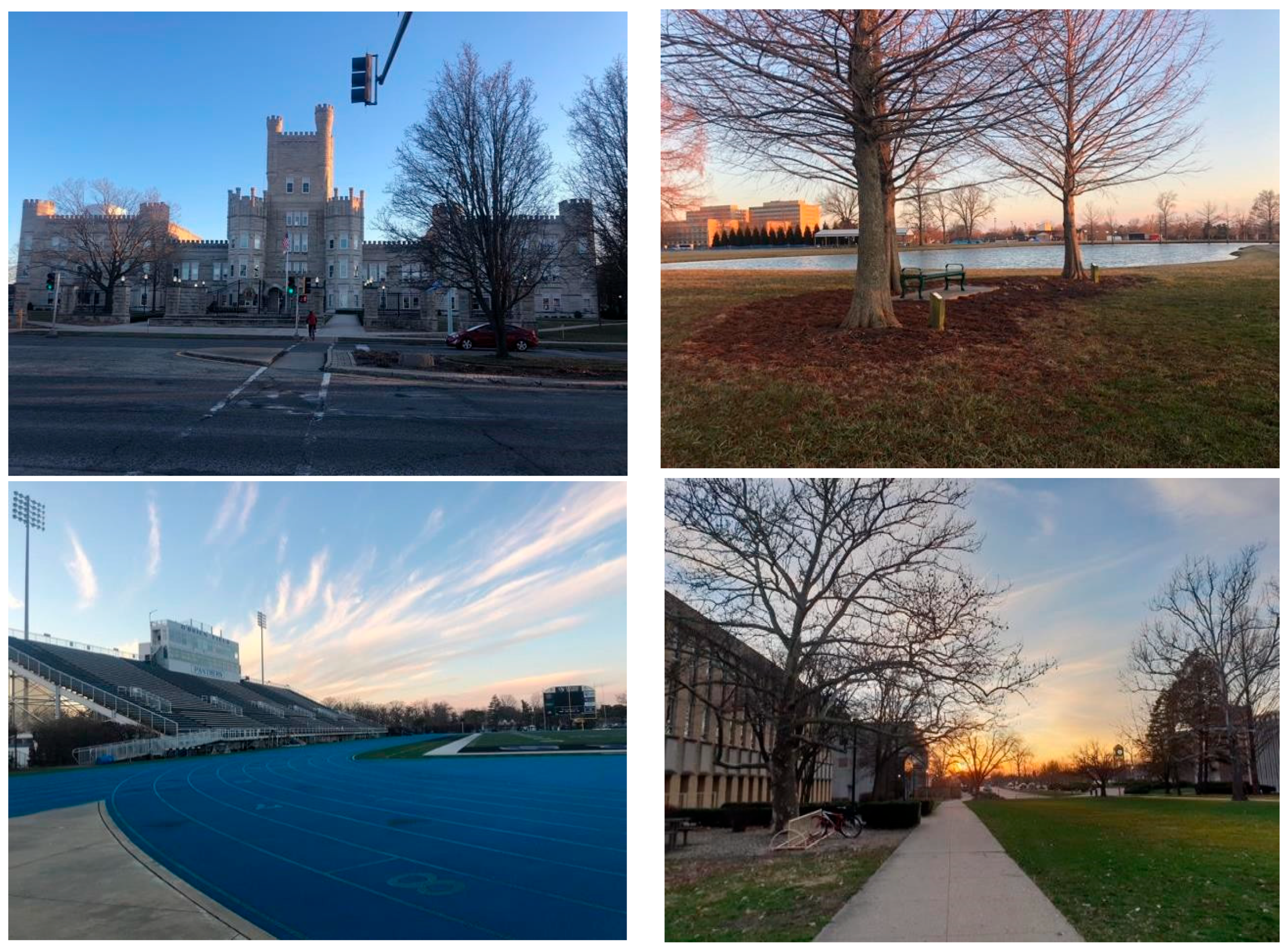
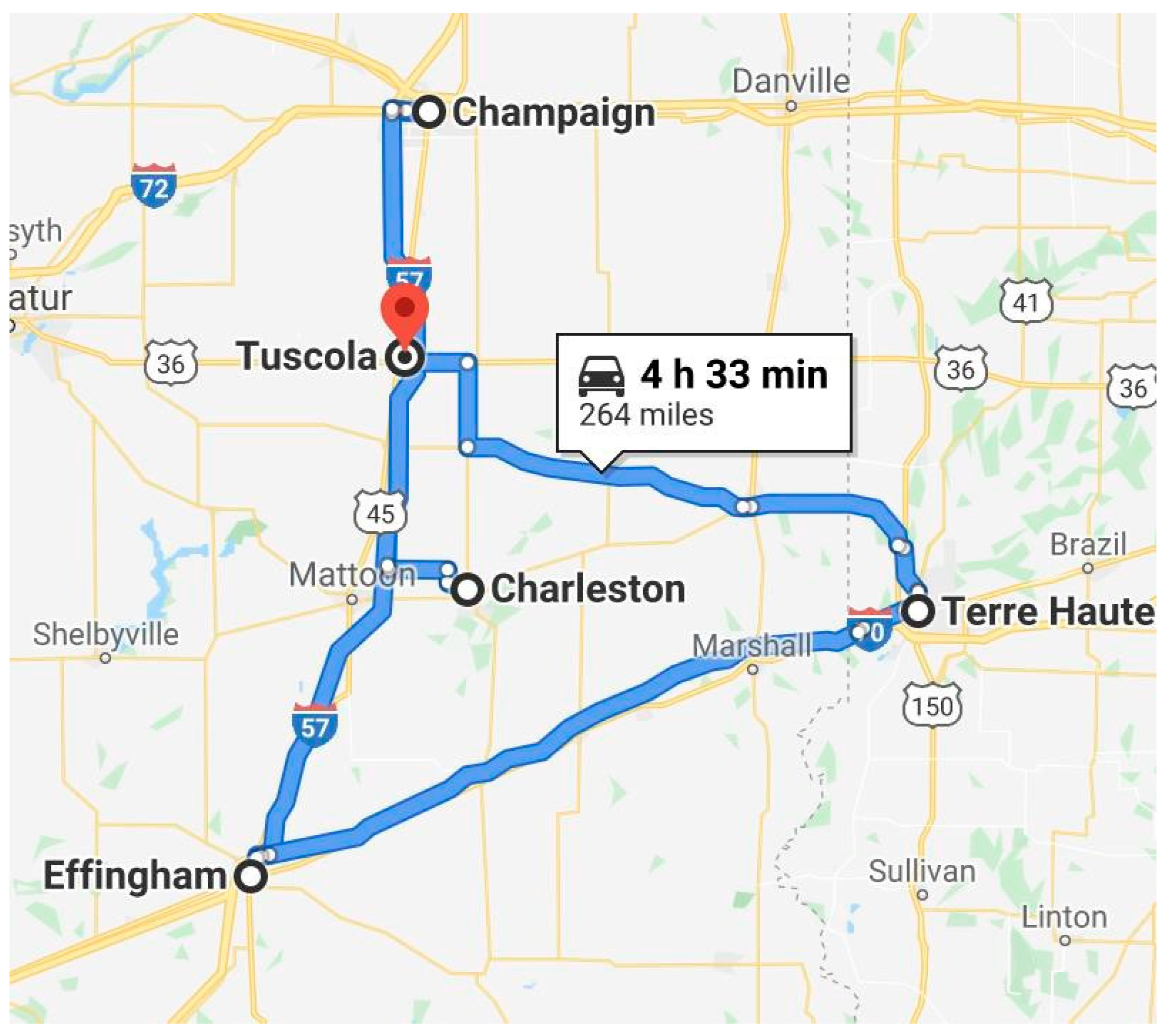
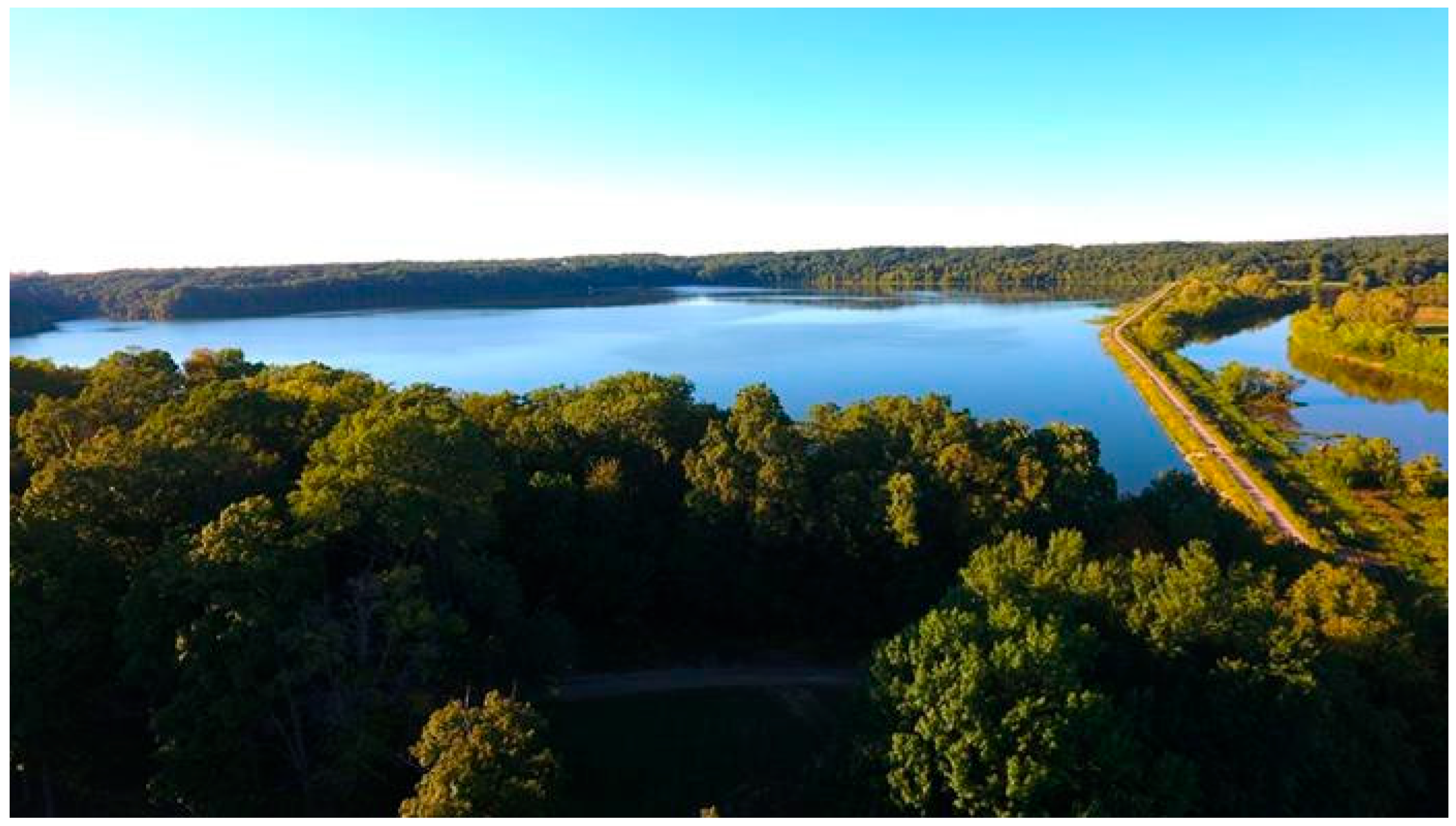

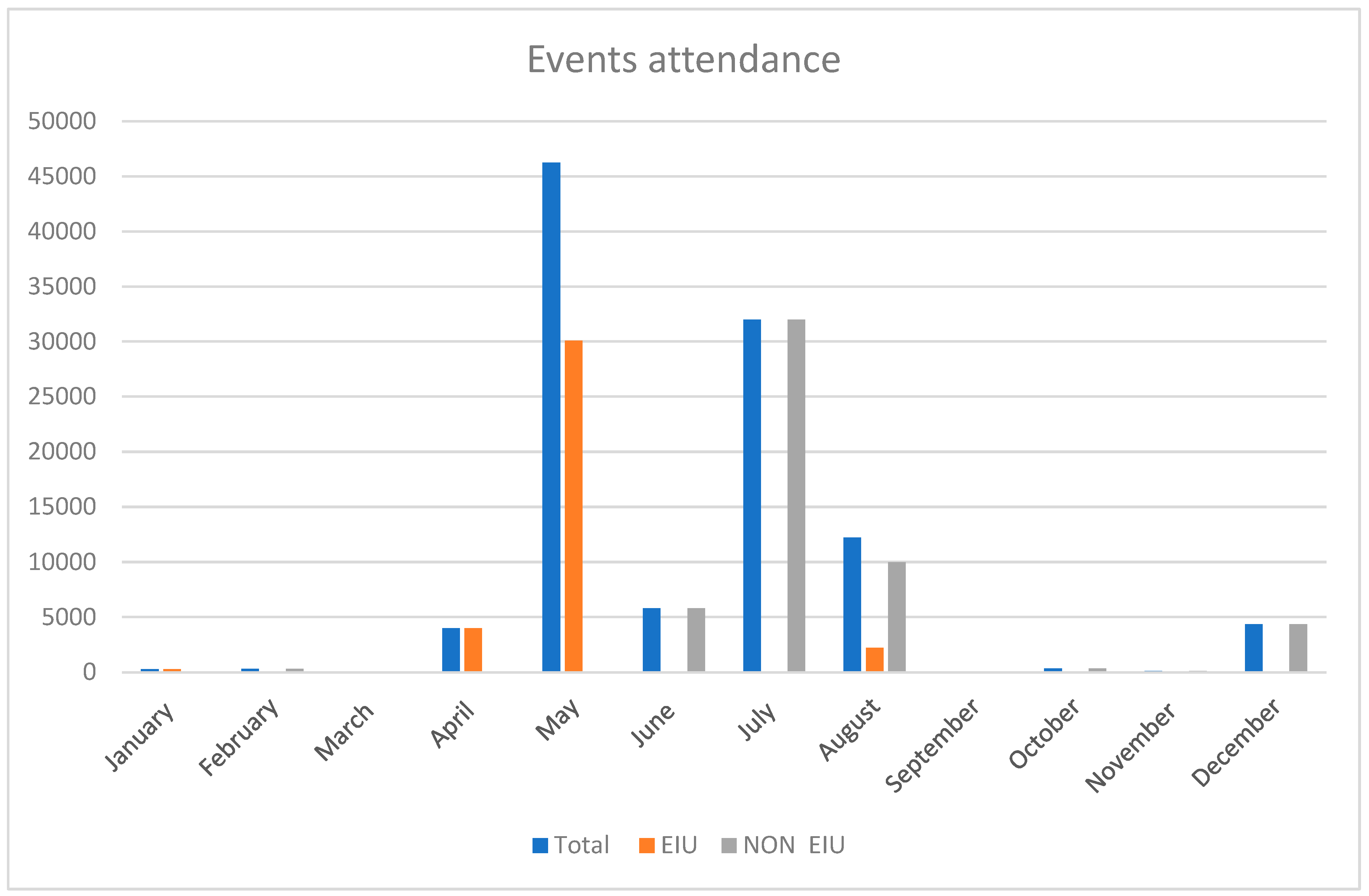
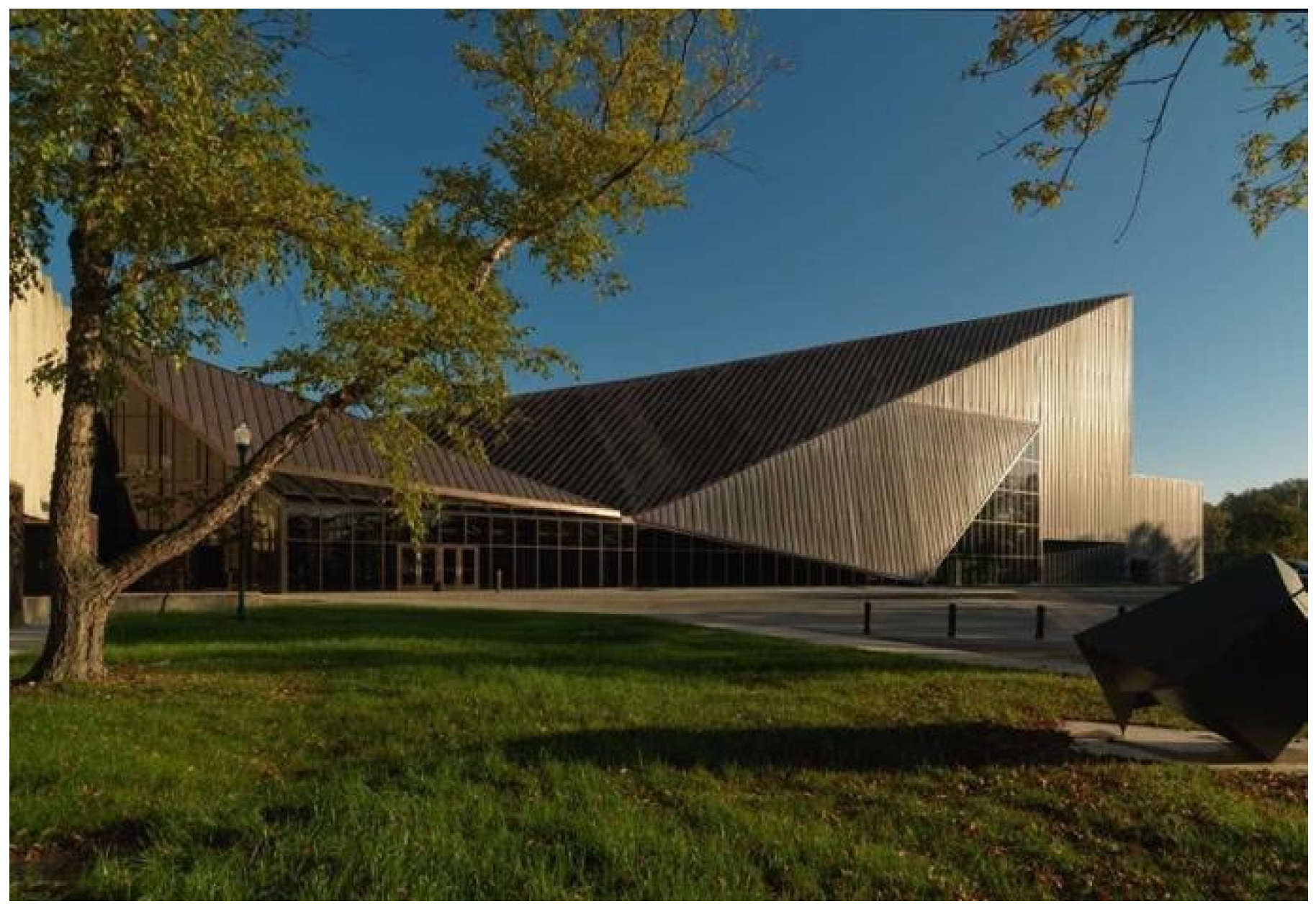

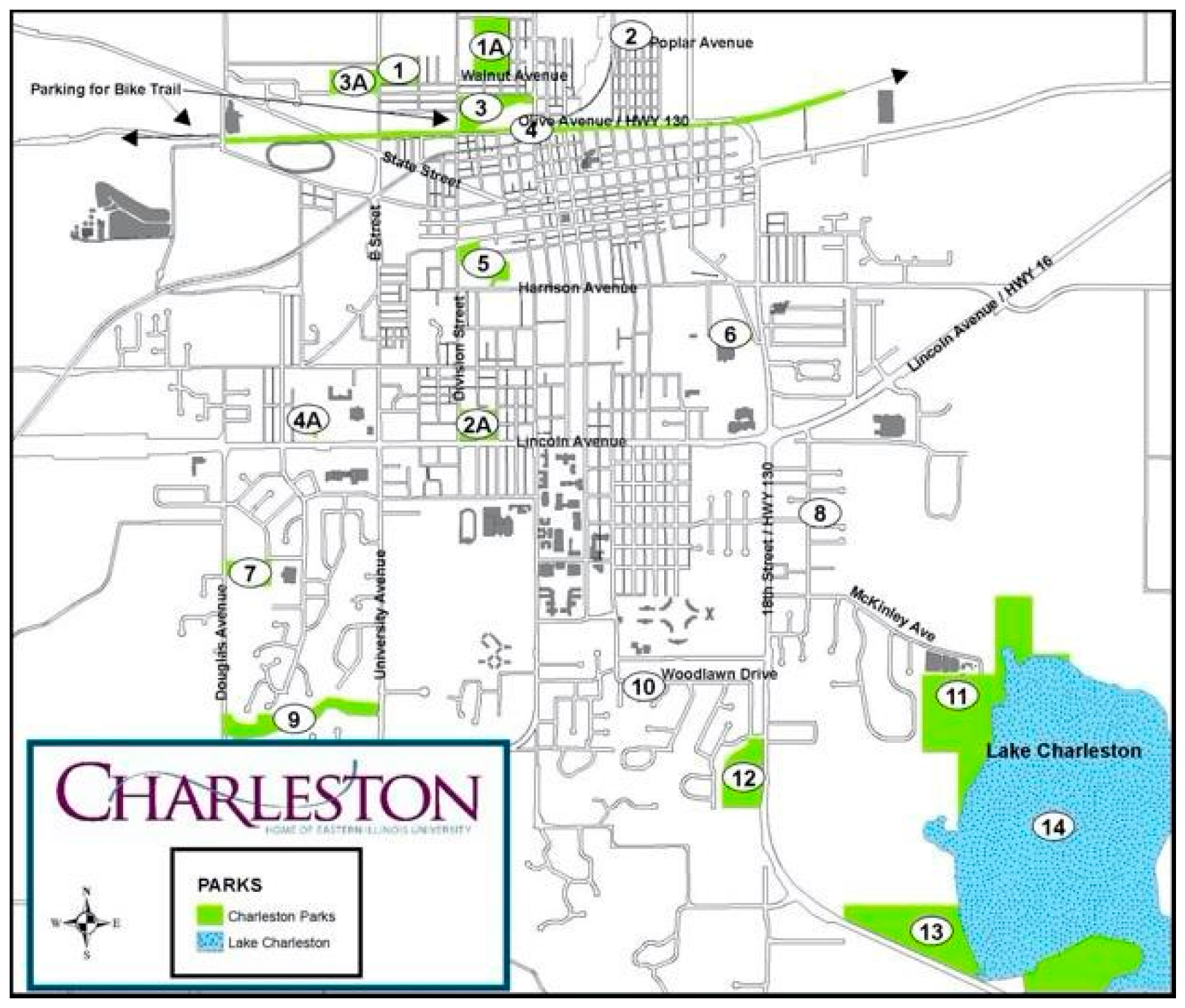
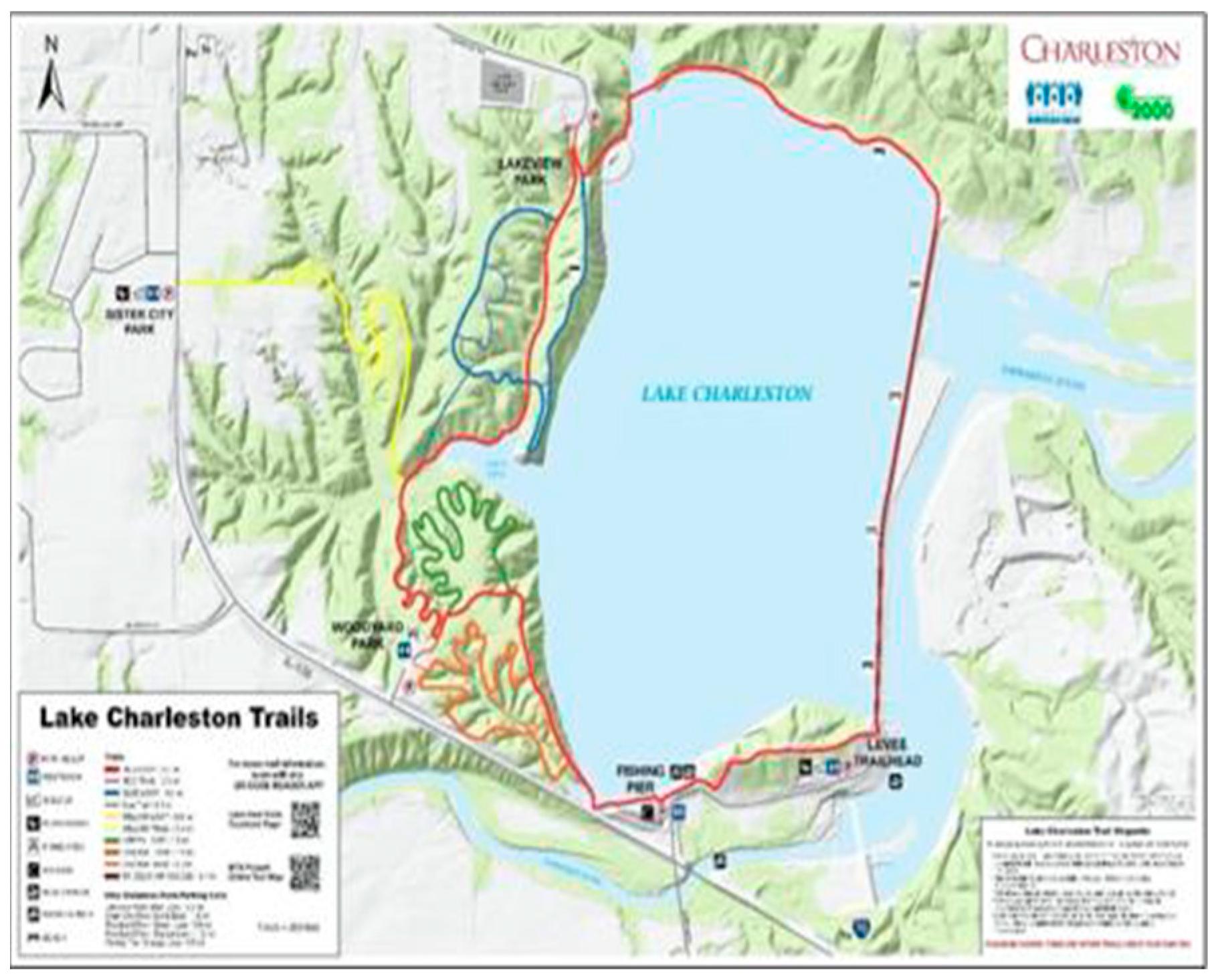
| Tourism Assets | Charleston Today |
|---|---|
| Architecture | Authentic and well-preserved historic buildings around the downtown square |
| Art | Doudna Fine Art Center, Tarble Art Center, museums, Charlestown Community Theater |
| Popular commerce | NA |
| Cuisine | NA |
| Customs | NA |
| Geography (landmarks, scenic attractions, and nature) | Lake Charleston: hike trails, fishing, bird watching, the Urban Butterfly Initiative |
| History | Abraham Lincoln History and museums |
| People (Notable figures) | Abraham Lincoln History and museums |
| Event | Location | Month | Average Attendance 2018, 2019 |
|---|---|---|---|
| IHSA Track Meets | EIU | May | 29,000 |
| Fireworks | Coles Co Airport | July | 21,000 |
| EIU Graduations | EIU | May | 16,175 |
| Red, White & Blue Days | Morton Park | July | 11,000 |
| Air Show 2018 | Coles Co. Airport | August | 10,000 |
| NSA South State Tournament | Ne-Co Fields | June | 5000 |
| Christmas in the Heart of Charleston | Square | December | 4350 |
| Destination Appeal | Destination Management | Destination Organization | Destination Information | Destination Efficiency |
|---|---|---|---|---|
| Attract The scenery: * The lake * The parks * The hiking trails * The bike paths | Management The tourism office | Management organization Organize events | Internal management information system Do not exist | Integrity of experience Peaceful town with proximity to nature |
| Deter No tourism services: * Activities: canoe, bike rental. * Limited accommodation * Limited restaurant options | Marketing Limited marketing effort: * Lack of advertisement * No social media presence * No independent website for tourism activities | Alliance No strategic alliance to attract tourists | Research Capabilities: Limited resources and research capabilities available | Productivity No estimated profit |
Disclaimer/Publisher’s Note: The statements, opinions and data contained in all publications are solely those of the individual author(s) and contributor(s) and not of MDPI and/or the editor(s). MDPI and/or the editor(s) disclaim responsibility for any injury to people or property resulting from any ideas, methods, instructions or products referred to in the content. |
© 2024 by the authors. Licensee MDPI, Basel, Switzerland. This article is an open access article distributed under the terms and conditions of the Creative Commons Attribution (CC BY) license (https://creativecommons.org/licenses/by/4.0/).
Share and Cite
Ben Miloud, Y.; Hugo, N. Tourism as a Solution for the Economic Revitalization of an American College Town. Tour. Hosp. 2024, 5, 672-688. https://doi.org/10.3390/tourhosp5030040
Ben Miloud Y, Hugo N. Tourism as a Solution for the Economic Revitalization of an American College Town. Tourism and Hospitality. 2024; 5(3):672-688. https://doi.org/10.3390/tourhosp5030040
Chicago/Turabian StyleBen Miloud, Yasmine, and Nichole Hugo. 2024. "Tourism as a Solution for the Economic Revitalization of an American College Town" Tourism and Hospitality 5, no. 3: 672-688. https://doi.org/10.3390/tourhosp5030040





